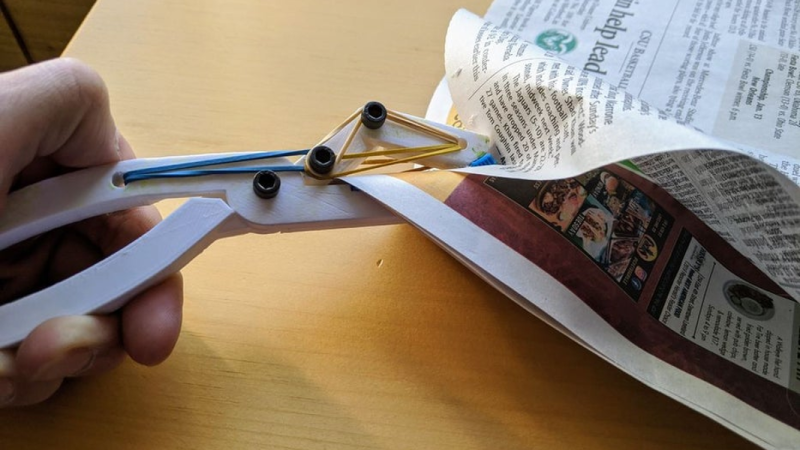We all know people trapped in aging bodies who can’t do all the things they used to do. It’s easy to accept that you may never move small furniture around by yourself again, but losing the ability to do something as simple as separating the pages of your newspaper to keep reading it is an end to enjoyment.
When [Randomcitizen4] visited his grandma over the holidays, she mentioned having trouble with this, among other things. He fired up his printer and got to work designing a device to help her get back to the funny pages. This simple gripper mechanism uses rubber bands for tension and flexible filament to get a firm grip on the paper. The jaws default to the open position so they’re ready to grab some newsprint, and a light squeeze of the handles slides the top page back from the stack, creating a gap for Grandma’s fingers. You can see a demo on page 32 after the break.
Although the device does work on some books and magazines, he’d like to improve the design of the grips to make the device more universally useful. [Randomcitizen4] says he tried a few things already, but we wonder if a more complex surface pattern might do the trick — maybe less like fins and more like a tire tread pattern. All the STLs are available if you want to give it a go.
If Grandma’s newspaper ever goes out of print, she should still be able to read it on a tablet or an e-reader. Then maybe [Randomcitizen4] can build some kind of remote-controlled page turner for her.
















“You can see a demo on page 32” +1
It might be useful to open plastic bags at the grocery store, too.
I used to have problems with those plastic bags, so common at places like Walmart (in the USA) where the bags are on metal stands and which are “supposed” to open automatically when you grab the bag before it. I watched one of the baggers. Simply wetting a forefinger lightly with your tongue, then rubbing forefinger with thumb to spread the moisture, allows one easily to open those plastic bags by “squishing” the bag edges between said forefinger and thumb and sliding finger/thumb back and forth. I would think the same thing would work with newspapers, but instead of using thumb, have a small damp sponge nearby (lest one become ill with tasting newsprint constantly). Still, kudos to grandson for trying to help out.
I would think the same thing would work with newspapers, but instead of using tongue, have a small damp sponge nearby (lest one become ill with tasting newsprint constantly).
There are murder mysteries that use the saliva on newsprint as a vector for poison :)
I’m partial to SortKwik and similar fingertip moisteners, which avoid the problem of having to lick your fingers and potentially spread diseases.
I keep a stack of post-its in my pocket for this. My local grocery store long ago went to bags for produce that are, for practical purposes, impossible to open without an aid.
– Always liked the Post-It story – “Dang it !! – this new stupid glue we jus came up with: – first it kinda sticks, then it doesn’t – kinda sticks, then it doesn’t…
—
Oh, ….Wait …
I don’t remember where I got the idea of using post-its for this. It was about 20 years ago. Maybe from Don Norman?
– best computer pwd? – stuck somewhere on the edge frame of yr monitor screen as a reminder:
– “blankyellowpostitnote”
Whip the corner over an edge, disturbing the perfect laminar form. Breathing on thumb and finger like fogging glasses up to clean is much cleaner than touching your tongue Separating papers is nothing compared to trying again and again to split those zip-lock packages after cutting the sealed top off. Trying to seal them shut is also a task of multi-try as well. Now I just cut the whole top off zip and all. The hack is folding the top over and using a wooden spring clothes pin to seal it shut.
Available for this purpose are rubber “thimbles”, or little rubber covers that just go over the ends of your fingers. Useful for people who handles lots of paper money or plastic bags.
Also useful so that money handler’s don’t get their fingerprints on the bills.
In the document processing industry, paper separation is a big deal. Millions have been poured into finding just the right synthetic compounds with an acceptable amount of drag across a wide range of materials with wildly varying Sheffield values. EPDM Rubber seems to be the current favorite, and can be bought in thick sheets very inexpensively.
This separator design is clever, and I think smooth EPDM would work wonderfully in place of the textured flexible filament.
Who knew I was so smooth they named an Instrument after me ?? lol
I have trouble with the large furniture, not the small 🤣
Back in the day of a summer job during high school (2 1/2 months of 1987), I worked in the print shop for an elementary school district. High speed printers would print 240 to 330 copies of math lessons and I had the job of sorting them into stacks of 30 (max class size). I would use the eraser of a standard Ticonderoga #2 pencil to push the corners of the pages up to count out 30 then rotate the stack. After a week or so, I could count out the groups of 30 as fast as the printers could print the pages. To this day, anytime I deal with numerous pages of printed material, I use a good old pencil eraser.